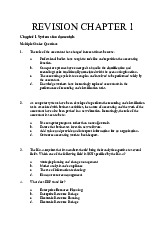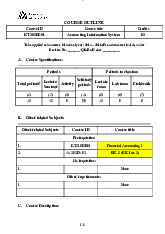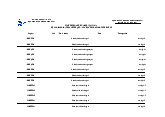




Preview text:
lOMoAR cPSD| 47205411 REVISION CHAPTER 2
Multiple Choice Questions 1.
Which are the three levels that strategy can be seen to operate at? (i) the internal level (ii) the external level
(iii) the business portfolio level
(iv) the inter-organisation level
(v) the intra-organisation level(vi) the competitive level a. i, ii, vi b. i, iii, vi c. iii, iv, v d. iv, v, iii 2.
An example of a strategic level decision would be: a.
Determining the quantity of raw materials to purchase b.
Appointing a new line manager responsible for running the delivery department c.
Reconfiguring the production line design to eliminate wasted time due to bottlenecks d.
Deciding whether or not to acquire the remaining shares of a partially owned subsidiary 3.
Michael Porter sees a business as having two options when deciding on a strategy. These two options are: a.
Economies of scale and entry barrier b.
Economies of scope and differentiation c.
Price competition and product abundance d.
Differentiation and cost leadership 4.
Michael Porter sees the implementation and attainment of strategies as consisting of
five steps. Which of the following is NOT one of the steps? a. Fit b. Uniqueness c. Operational efficiency d. Sustainability 5.
Michael Porter puts forward five forces that shape the industry in which a firm
operates. Which of the following is NOT one of the forces? a. Threat of new entrants b.
Legislative power of the government lOMoAR cPSD| 47205411
Testbank to accompany: Accounting information systems 4e c.
Rivalry among existing competitors d.
Threat of substitute products or services 6.
There are two perspectives of organisational design: a. Logical and physical b. Internal and external c.
Functional and business process d. Scientific and practical 7.
The logical consequence of Taylor’s scientific management approach was that organisations: a.
Developed rigid hierarchies that sought to tightly control lower levels of the organisation. b.
Developed highly interactive and flexible structures that could easily adapt to changing environments. c.
Had employees who questioned procedures and sought to continually redefine their role. d.
Streamlined the information flows across the organisation. 8.
Scientific management is concerned with: a.
Streamlined work flows across the organisation. b.
Hierarchical control of the organisation through three levels of management. c.
Clearly defining individual employee’s responsibilities and tasks. d.
Dividing the business structure into the optimal number of functional divisions. 9.
Which of the following is not a benefit of a functionally based organisational design? a. Control and coordination b. Stability c. Communication efficiency d. Task specificity
Chapter 2: Systems characteristics and considerations 10.
Which of the following is not a problem or limitation of a functionally based organisational design? a.
Not reflective of the reality of today b. Lack of administrative power c.
Slow to react to the environment d. Focuses on the wrong things lOMoAR cPSD| 47205411 11.
An emphasis on business processes is different to a functional perspective of the
organisation because a business process emphasis: a.
Offers highly defined tasks and responsibilities. b.
Gives employees the freedom to do what they want in order to please the customer. c.
Acknowledges cross-functional communication and action is essential to the customer’s needs. d.
Views the customer needs as secondary to those of the functional divisions. 12. What is a business process? a.
a series of interlocking activities that work together across the organisation to
achieve some predetermined organisational goal. b.
any activity performed by a business c.
any core activity that produces a profit d.
any activity performed by a manufacturing company providing that it produces a profit 13.
The major difference between a business process and a business function is that: a.
business processes emphasises what gets done, business functions emphasise how it gets done b.
business process personnel are highly skilled specialists, business function
personnel are generalists operating across numerous areas c.
business processes emphasise vertical structure and hierarchy, business
functions emphasise the horizontal integration of the organisation d.
business processes are customer driven, business functions are task driven 14.
A sales person is processing a credit sale. As per company policy, the sales person
should conduct the credit check and forward the result to a supervisor, who would
then make a decision on the creditworthiness of the applicant and send this back to the
sales person. This scenario is more likely to happen in: a.
Functionally based organisation
© John Wiley & Sons Australia, Ltd 2012 b.
Business process based organisation c.
Both functionally based organisation and business process based organisation d.
Neither functionally based organisation nor business process based organisation 15.
Which of the following is NOT a benefit of adopting a business process perspective within the organisation? lOMoAR cPSD| 47205411
Testbank to accompany: Accounting information systems 4e a.
Better customer service and customer relations. b.
Greater efficiency and effectiveness in using resources. c.
Tighter organisational control. d.
Less non-value-adding activities. 16.
In the process perspective of the organisation, a flattened organisational design cannot: a. Increase task specificity b. Reduce bureaucracy c.
Create a more flexible organisation d.
Identify tasks and functions that do not add value 17.
Business processes can provide an organisation with a competitive advantage. This
competitive advantage is more likely to come from: a.
The design of business processes that are more efficient and effective b.
The design of business processes that are unique or offer something different c.
The design of business processes that are more competitive and flexible d.
The design of business processes that have lower costs of execution 18.
The business process can yield benefits for an organisation through: a.
Ignoring customer service and focussing on superior product design b.
offering customers cheaper prices c.
outsourcing all customer service activities d.
improved customer service and customer relations through a value adding emphasis
Chapter 2: Systems characteristics and considerations 19.
Although ERP systems are built around the idea of best practice, some organisations
will choose not to adopt the ERP best practice, seeking instead to modify the design
of the system. The mostly likely reason for doing so is: a.
Modifying the ERP system will lower the cost of implementation because
redundant features are removed. b.
The ‘fit’ between the system and the business processes needs to exist. Ii is
easier to change the system than to change the organisational design. c.
The ERP system is unable to drive some of the organisation’s unique business
processes that provide distinct competitive advantage to the organisation. d.
Adopting an ERP system off the shelf erodes competitive advantage because
everyone else has the same software at their disposal. 20. An ERP system is: lOMoAR cPSD| 47205411 a.
A complex set of computer program modules that integrate the different
functional areas of the organisation. b.
Developed around an information silo principle. c.
A system that integrates functional and proprietary information systems in
different departments in an organisation. d.
Suitable for both large and small organisations. 21.
Because of ERP’s best practice approach, if all organisations adopt the ERP system
and have the same underlying processes, they are less likely to distinguish themselves
and gain a competitive advantage. This is likely a major reason for: a. Not adopting ERP. b.
Adopting ERP before competitors do. c.
Configuring a business process around an ERP system. d.
Not configuring a business process around an ERP system. 22.
Which of the following is NOT a result of moving to a business process-based environment? a.
The way that the organisation is managed is changed. b.
Functional barriers are broken down. c.
The layer of middle management is thickened. d. Employee resistance. 23.
The first stage in adopting a business process perspective is that: a.
it should focus on removing middle management b.
it must be represented in the design of the organisation. c.
it should emphasise the flattening of the organisational structure. d.
it must be reflected in the organisation’s latest statements.
© John Wiley & Sons Australia, Ltd 2012 Short Answer Questions
1. Michael Porter sees a business as having two options when deciding on a strategy: (1) cost
leadership or (2) differentiation. Discuss the difference and the relationship between these two options.
2. What are the benefits and problems of the functional perspective of the organisation?
3. Compare and contrast business process with business function.
4. Identify and briefly explain the eight steps that should be followed to manage successfully
the transformation of an organisation to a process prospective.



